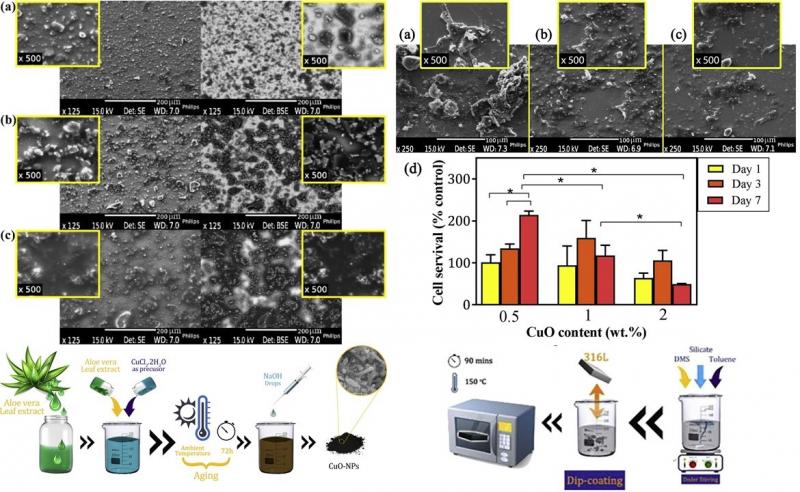- English
- فارسی
2013-Tavakoli.S.
 |
 |
 |
Shima Tavakoli
Email: shima.tavakoli@ma.iut.ac.ir, shimatavakoli1995@gmail.com
- BSc, (2013-2017): Embedding CuO nanoparticles in PDMS-SiO2 coating to improve antibacterial characteristic and corrosion resistance
Abstract:
The purpose of this paper was to develop the hydrophobic nanocomposite coatings of polydimethylsiloxane (PDMS)-SiO2-CuO to improve biocompatibility, corrosion resistance and antibacterial property of 316 L stainless. In this research, after synthesize of CuO and SiO2 nanopowders using wet-chemical approaches, PDMS-SiO2-CuO coatings consisting of various amounts of CuO nanoparticles were developed using dip-coating process. The nanocomposite coatings were characterized with regard to the structural and physical properties, corrosion resistance, antibacterial activity and cellular interactive responses. The results showed that incorporation of CuO nanoparticles <2 wt% improved the corrosion resistance of 316 L stainless steel. At higher CuO nanoparticle contents (>1 wt%), the agglomeration of nanoparticles and their cytotoxic effects resulted in reduced antibacterial characteristics and MG63 cell viability and proliferation. In summary, PDMS-SiO2-CuO nanocomposite coating with significant antibacterial and anticorrosion behavior could be a promising coating for biomedical implants.
Outcome: 1st Paper, 2nd Paper, 3rd Paper

- MSc, (2017-2019): Synthesis and Characterization of sprayable Kappa-Carrageenan-ZnO/PD hydrogel for healing diabetic wound
Abstract:
Diabetic wounds are one of the most concerns all over the world. Debility of immune system and bacterial infection prolong wound healing, leading to formation of chronic wounds. Sprayable bioadhesives with exceptional therapeutic results, appropriate mechanical properties, antibacterial activity and blood coagulation could have excessive practical importance in healthcare, particularly for chronic diabetic wound healing. In this study, a visible light-crosslinkable nanocomposite bioadhesive hydrogel with multifunctional properties has been proposed. While methacrylated Kappa-carrageenan (KaMA), mimicking the natural glycosaminoglycan was applied as the hydrogel matrix. Firstly the visible light crosslinking ability was induced to this sprayable hydrogel and gel properties was optimized by variation methacrylation degree and polymer concentratin based on native skin characteristics. Afterward, various concentrations of polydopamine modified ZnO (ZnO/PD) nanoparticles (0, 0.5, 1 and 2 wt.%) was loaded in it to improve its mechanical, antibacterial and cellular properties. Moreover, L-glutamic acid was incorporated in the nanocomposite hydrogel network to accelerate wound healing. The nanocomposite hydrogel revealed appropriate tensile and compressive property and recovery ability, comparable elasticity with human skin and great adhesiveness. The nanocomposite hydrogel demonstrated effectual blood clotting ability and biocompatibility. In vivo experiments also suggested that L-glutamic acid loaded nanocomposite hydrogel considerably accelerated wound healing with superior granulation tissue thickness than control in a full-thickness skin defect model. Taken together, this visible-light crosslinking nanocomposite hydrogel with significant properties could be used to spray on a wound area to eliminate wound infection and accelerate wound healing process.
Outcome: Paper


